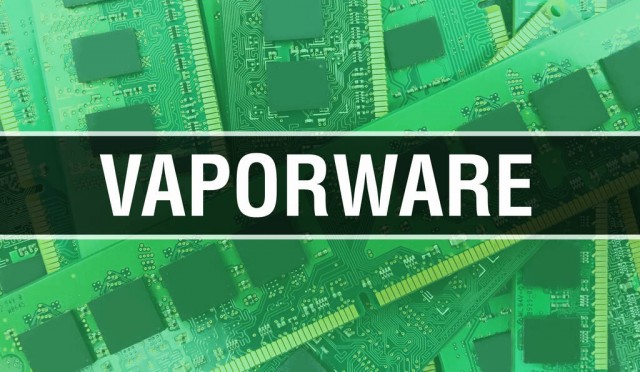The crypto world is full of bold ideas, groundbreaking promises, and ambitious roadmaps. But hidden among the genuine innovators is a particular breed of project known as vaporware—a slick presentation of grand visions that never actually materialize.

In simple terms, vaporware refers to blockchain protocols, DApps, or tokens that promote big solutions to problems that either don’t exist or are exaggerated for marketing purposes. These projects often lean heavily on buzzwords like “decentralization,” “revolutionary technology,” or “ecosystem transformation,” yet fail to deliver anything beyond concept art and talk.
And while vaporware didn’t start in crypto, this industry has given it more room to thrive than ever before.
A Brief History: Vaporware Before Crypto
The idea of vaporware predates blockchain by decades. The tech industry in the 1970s and 80s saw numerous “next big things” that never made it past prototypes. Classic examples include:
Atari’s Mindlink controller
Sinclair’s futuristic-but-impractical C5 vehicle
These products generated excitement but collapsed long before reaching consumers. The pattern is familiar: big promises, massive hype, minimal delivery.
Crypto simply inherited—and amplified—the same behavior.
How Vaporware Took Over Crypto
The rise of cryptocurrencies, especially during the ICO boom, opened the door for countless “next Ethereum killer” projects. Many raised millions based solely on whitepapers and exaggerated claims.

Source: create.vista.com
Why does crypto attract vaporware?
- Low barriers to raising capital
- Unregulated environments
- High investor FOMO during bull markets
- Influencer-driven hype cycles
In such a setting, a team can raise millions without ever shipping a working product.
Why Vaporware Happens
There are a few primary drivers:
1. Hype-first, skills-later
Some teams dream up ambitious products but lack the technical ability to build them.
2. Fast fundraising opportunities
Crypto’s fundraising mechanisms reward big promises, even when execution is unrealistic.
3. Marketing > development
Many vaporware projects invest more in influencers, PR, and community hype than in actual engineering.
4. Unrealistic ambitions
Some ideas—like fully immersive Web3 metaverses—sound amazing but are decades ahead of current technology.
The Damage Vaporware Does
Vaporware doesn’t just disappoint investors—it harms the broader ecosystem.
- Financial loss: Investors pour money into projects that never launch.
- Market instability: High-profile failures shake confidence across the industry.
- Skepticism toward new builders: Real innovators must work harder to prove legitimacy.
- Token collapses: When promised features don’t appear, token prices crash.
For every legitimate project, there are dozens of vaporware tokens crowding the space with noise.
Is Vaporware Illegal?
Not necessarily. Announcing a product that’s still in development isn’t a crime.
However, misrepresenting progress or capabilities to attract investment is fraud. Regulators like the SEC have taken action against deceptive ICOs, but the crypto industry remains a “wild west” where questionable projects still thrive.
How to Spot Vaporware Before It’s Too Late
Identifying vaporware isn’t always straightforward, but certain red flags can help you make a smarter assessment.
1. Do Thorough Research
Legitimate projects provide:
- Clear technical plans
- Realistic roadmaps
- Transparent team backgrounds
Vaporware, on the other hand, often relies on vague descriptions and hype-heavy marketing.
2. Scrutinize the Whitepaper
A strong whitepaper should include:
- Step-by-step execution plans
- Logical timelines
- Defined utility for the token
If it’s all vision and no actionable detail, that’s a problem.
3. Check Team Transparency
A project with anonymous founders, no LinkedIn profiles, or unverifiable credentials is a major red flag.
4. Evaluate the Community
Is the conversation centered on product development, or is it just people shouting, “When moon?”
Hype-only communities often signal weak fundamentals.
5. Look for a Working MVP
A minimum viable product is one of the strongest signs a project is serious. No prototype? No proof? Be careful.
6. Avoid the Shiny New ICO Trap
New token launches are where most vaporware thrives. Stick to projects with established credibility.
How Crypto Teams Can Avoid Becoming Vaporware
Not every underdeveloped idea is malicious—some teams genuinely overestimate what they can achieve. To avoid turning into vaporware, projects should:
- Release realistic roadmaps with achievable milestones
- Build trust through transparency and regular updates
- Launch an MVP before seeking major funding
- Avoid hype-driven marketing that promises more than the tech can deliver
In Web3, credibility is earned by shipping, not talking.
Final Thoughts: Staying Safe in a World Full of Promises
Vaporware is inevitable in any fast-growing industry, especially one as experimental as crypto. But with careful due diligence, investors can sift through the noise and focus on projects with real potential.
Learn from market wizards: Books to take your trading to the next level

 Hot Features
Hot Features











